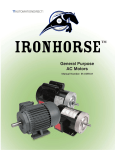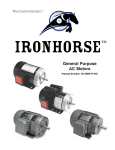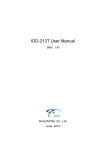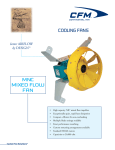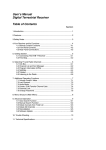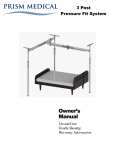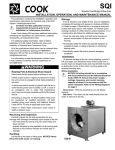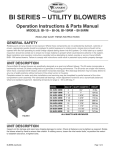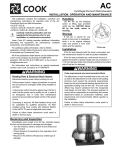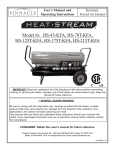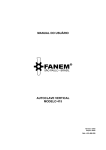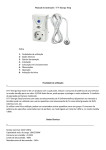Download IH-USER-M-WO – Chapter 5: Reference
Transcript
REFERENCE CHAPTER 5 1 In This Chapter... Using IronHorse Motors with AC Drives . . . . . . . . . . . . . .5–2 Voltage Spike Considerations for AC Drive Control . . . . . . . . .5–2 Double Punched Motors . . . . . . . . . . . . . . . . . . . . . . . . . .5–3 F1 and F2 Mounting . . . . . . . . . . . . . . . . . . . . . . . . . . . . .5–4 Junction Box Dimensions . . . . . . . . . . . . . . . . . . . . . . . . .5–5 Minimum Sheave Diameters . . . . . . . . . . . . . . . . . . . . . . .5–6 Decibel Levels . . . . . . . . . . . . . . . . . . . . . . . . . . . . . . . . . .5–7 Shipping Crate Dimensions . . . . . . . . . . . . . . . . . . . . . . .5–8 Chapter 5: Reference Using IronHorse Motors with AC Drives IronHorse general purpose motors can be controlled by across-the-line starters such as contactors and manual motor starters. Under certain circumstances, it can be more desirable to control a three-phase IronHorse motor with an AC drive. Single phase AC motors cannot be controlled by typical AC drives The advantages of using an AC drive include: • Lower inrush current at motor startup. • Ability to change motor speed at any time. • Greater efficiency in some applications. Fan and Pump applications can use an AC drive to provide motor flow control by varying the motor speed. • Solid state power delivery meaning minimum maintenance. There are a few considerations to take into account when an AC drive is chosen for motor control. Fan cooled motors are designed to provide sufficient insulation cooling when the motor is running at the rated speed. The cooling ability of the fan is reduced when motors run at lower speeds. Therefore, there are limitations on how slowly general purpose motors can be continuously run without prematurely causing insulation failure. • Constant torque (CT) applications – 2:1 (1/2 of the rated speed) – The CT minimum continuous speed for an IronHorse general purpose motor is half of its rated speed, as shown in the motor Performance Data tables. (Constant torque loads require the same amount of torque from the motor regardless of speed; e.g., conveyors, cranes, machine tools.) • Variable Torque (VT) applications – 5:1 (1/5 of the rated speed) – The VT minimum continuous speed for an IronHorse general purpose motor is one fifth of its rated speed, as shown in the motor Performance Data tables. (Variable torque loads require less torque at lower speeds, resulting in less heat generated by the motor; e.g., fans, centrifugal pumps.) The insulation of IronHorse motors in both of the above applications can withstand voltage stress per NEMA Part 30 having a value of: • Base Voltage Rating 울 600V • Vpk = 1kV • Rise Time = 2µs AutomationDirect offers a line of AC Drives that are suitable for operating IronHorse motors per the above specs and NEMA part 30. Voltage Spike Considerations for AC Drive Control All AC drives can cause voltage spikes between the drive and the motor. Long cable lengths can increase these spikes. Therefore, there are maximum cable lengths that can be run between the drive and the motor. Line (load) reactors can also be installed near the drive output to reduce the voltage spikes. • 230V & 460V without reactor – 125 ft maximum cable length between the drive and motor. • 230V & 460V with reactor – 250 ft maximum cable length between the drive and motor. To avoid overheating, the AC Drive carrier frequency must be set at or below 6kHz. 5–2 IronHorse General Purpose Motors User Manual 3rd Edition 06/2009 Chapter 5: Reference Double Punched Motors Several IronHorse motor models have mounting feet that are double punched so that larger frame motors can be mounted using the same dimensions of different size frame motors. This can be helpful when replacing a motor with a different frame size. See Chapter 2: Mounting and Initial Startup for complete motor dimensions. Motor Mounting Bolt Sizes Frame Size * Double Punched Punched for Additional Frame Size 56 143T 145T 182T 184T 213T 215T 254T 256T 284T 286T 324T 326T 364T 365T 405T 444T 445T 445/7T 449T Yes 143T No Yes 143T No Yes 182T No Yes 213T No Yes 254T No Yes 284T No Yes 324T No Yes 364T Yes 404T No Yes 444T Yes 445T No * TC-frame motors have the same mounting foot punching as the comparable T-frame motors. 3rd Edition 06/2009 IronHorse General Purpose Motors User Manual 5–3 Chapter 5: Reference F1 and F2 Mounting F1 and F2 mounting refers to the location of the junction box on an AC motor. Several models of IronHorse motors can be converted from F1 to F2 mounting. F1 to F2 Mounting Convertibility Frame Size * 56 143T 145T 182T 184T 213T 215T 254T 256T 284T 286T 324T 326T 364T 365T 405T 444T 445T 445/7T 449T Ability to be Converted No (F1 only) Yes (F1, convertible to F2) No (F1 only) Yes (F1, convertible to F2) No (F1 only) * TC-frame motors have the same convertibility as the comparable T-frame motors. Drive End F1 Mounting F2 Mounting To minimize the potential of damage to any internal component, use caution when pulling the rotor from the frame when converting an IronHorse motor from F1 to F2 mounting. Authorized EASA service centers are equipped with the necessary equipment to quickly and inexpensively convert motor mounting. Visit the EASA website at www.easa.com to find the nearest authorized service center. 5–4 IronHorse General Purpose Motors User Manual 3rd Edition 06/2009 Chapter 5: Reference Junction Box Dimensions HH XD XC AA Junction Box Dimensions Frame Size * 56 143T 145T 182T 184T 213T 215T 254T 256T 284T 286T 324T 326T 364T 365T 405T 444T 445T 445/7T 449T XD Width XC Height HH Depth AA Conduit Hole (NPT) 3.23” 3.7” 1.55” 1/2” 4.1” 4.5” 2.3” 3/4” 4.6” 5.0” 2.6” 1” 6.3” 7.2” 3.3” 1-1/2” 9” 10.6” 5.3” 2” 9.8” 11.3” 3” 11.7” 7.1” 3” (2 openings) * TC-frame motors have the same junction boxes as the comparable T-frame motors. 3rd Edition 06/2009 IronHorse General Purpose Motors User Manual 5–5 Chapter 5: Reference Minimum Sheave Diameters The table below illustrates the minimum practical V-belt sheave diameter that can be used with each frame size IronHorse motor. Minimum Sheave Diameters V-Belt Sheave (2) Frame Size (1) Conventional A, B, C, D and E (3) Minimum Pitch Diameter Narrow 3V, 5V and 8V (4) Minimum Outside Diameter 143T 145T 182T 184T 213T 215T 254T 256T 284T 286T 324T 326T 364T 365T 405T 444T 445T 449T 2.2” 2.2” 2.4” 2.4” 3.0” 3.0” 3.8” 3.8” 4.4” 4.6” 4.4” 5.0” 5.4” 5.2” 6.0” 6.0” 6.8” 6.8” 7.4” 7.4” 9.0” 10.0” 11.0” N/A 8.6” 9.5” 10.5” 13.2” Notes: 1) TC-frame motors have the same minimum sheave diameters as the comparable T-frame motors. 2) Sheave dimensions are based on the following: a) Motor nameplate horsepower and speed. b) Belt service factor of 1.6 with belts tightened to the belt manufacturers recommendations. c) Speed reduction of 5:1. d) Mounting of sheave on motor according to sheave manufacturers instructions. e) Center-to-center distance between sheaves approximately equal to the diameter of the larger sheave. f) Calculations covered by the standards listed in notes 2 & 3 below. 3) As covered by IP-20; Specifications for Drives Using Classical V-Belts and Sheaves. Go to www.mpta.org and www.rma.org for details. 4) As covered by IP-22; Specifications for Drives Using Narrow V-Belts and Sheaves. Go to www.mpta.org and www.rma.org for details. 5–6 IronHorse General Purpose Motors User Manual 3rd Edition 06/2009 Chapter 5: Reference Decibel Levels The decibel (sound) level of an IronHorse motor should be measured after initial startup, after 30 days, and after six months of use. Decibel levels should remain fairly consistent and can be an indication of misalignment and premature bearing wear. If the measured decibel level for your IronHorse model exceeds the value listed below by more than 10%, contact AutomationDirect or a local motor service technician found at www.easa.com. Average T-frame Decibel Levels Frame Size * 143T 145T 182T 184T 213T 215T 254T 256T 284T 286T 324T 326T 364T 365T 405T 444T 445T 445/7T 449T HP Noise Level: Lw dB(A) 1 64.0 1-1/2 68.0 2 68.8 3 74.0 5 73.0 7-1/2 78.4 10 74.3 15 74.6 20 74.0 25 75.0 30 76.1 40 76.4 50 77.0 60 77.1 75 78.0 100 78.1 125 78.3 150 79.4 200 79.4 250 81.0 300 81.4 * TC-frame motors have the same sound ratings as the comparable T-frame motors. 3rd Edition 06/2009 IronHorse General Purpose Motors User Manual 5–7 Chapter 5: Reference Shipping Crate Dimensions Nominal Shipping Crate Dimensions Frame Size * HP Width x Depth x Height (in) 1/3 1/2 56C 3/4 1 1-1/2 2 143T 145T 145T 182T 184T 213T 215T 254T 256T 284T 286T 324T 326T 364T 365T 405T 444T 445T 445/7T 449T 15 x 11 x 10 17 x 11 x 10 1 1-1/2 14 x 11 x 17 2 3 5 7-1/2 10 15 20 25 30 40 50 60 75 100 16 x 14 x 20 18 x 16 x 25 31 x 23 x 22 33 x 24 x 24 36 x 26 x 25 39 x 28 x 27 44 x 32 x 30 125 150 47 x 33 x 32 200 250 300 63 x 33 x 37 * TC-frame motors ship in the same crates as the comparable T-frame motors. Shipping weights are listed in the Motor Specifications tables in “Chapter 1: Getting Started.” 5–8 IronHorse General Purpose Motors User Manual 3rd Edition 06/2009








